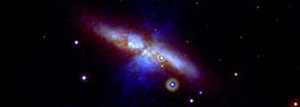UV Insights Into Two Classes of Type Ia Supernovae

[Note added April 19: Tom Beal of the Arizona Daily Star has written a nice article HERE with extensive quotations from Nick Suntzeff of Texas A&M, and others.]
Peter Milne of Steward Observatory, Gautham Narayan of NOAO and UA, and collaborators Ryan Foley and Peter Brown have discovered two types of nearby Type Ia supernovae. These sub-classes of Ia supernova mostly differ in their UV-light output. They are called UV-red and UB-blue: the UV-red objects dominate locally. At high redshift, the UV-blue objects dominate. The optical colors also subtly change, leading to a possible misinterpretation, using the regular analysis, of the reddening and distance to the supernova. This change of type of supernova with the age of the Universe at time of explosion has implications for the fundamental parameters of cosmology, since the identical objects are not being compared as astronomers look farther away into the Universe. There is a distance error as a function of redshift, which will change the derivation of the cosmological parameters. While the observational underpinnings of the need for dark energy will not disappear, the precise values of the cosmological parameters, including the amount of dark energy, will change, probably at a low level. Theoretical models of supernovae will need to explain these observations.

For Public
Public events include our Monday Night Lecture Series, world-reknowned Astronomy Camp and Mt Lemmon Sky Center.

For Students
A good place to start if you want to become an undergrad major or grad student, or need to find our schedule of classes.

For Scientists
Find telescopes and instruments, telescope time applications, staff and mountain contacts, and faculty and staff scientific interests.




